|
Me Sahyadri |
|
April 2014 |
|
Volume 1, number 1 |
|
Please use minimum 1280 pixel horizontal screen
resolution for viewing. Please be patient while all the images in
webpage are loaded. |
|
Please do not use the images for any commercial
use without permission. Text in Marathi and English is not exact
translation. Special thanks to all those who helped me during the compilation and field work for the help and guidance |
|
|
|
|
देशाची आर्थिक प्रगती व्हावी असे सर्व नागरिकांना वाटणे सहाजिक आहे. अर्थकारणामुळे मिळणारा रोजगार, समृद्धी यासाठी सर्वांनाच आर्थिक प्रगती हवी हवीशी वाटते. आर्थिक प्रगती होताना, त्याचा दिर्घकाळात समाजावर, निसर्गावर, वातावरणावर दुष्परिणाम होणार नाही याची काळजी घेणे महत्वाचे आहे. मनुष्याच्या भावी पिढ्यांना पाणी, शुद्ध हवा, योग्य वातावरण मिळत रहावे अशी भावना मनात रुजणे महत्वाचे आहे. वाढत्या आर्थिक प्रगतीमुळे नैसर्गिक संपदेवर ताण येतो. प्रगतीसाठी प्रदुषण होते. जंगले, माळराने, व इतर अधिवास नष्ट होतात. वसुंधरेवर रहाणाऱ्या इतर जीवांचा मात्र मनुष्य फारसा विचार करत नाही. आर्थिक प्रगती करताना, मनुष्य निसर्गाची हानी करत आहे. मुळताच माणसाला निसर्गाचे महत्व समजणे हे सध्याच्या आपल्या प्रगत जीवनशैली मुळे अवघड झाले आहे. आर्थिक प्रगती, समाजाची प्रगती व निसर्ग संपदेची निगा, यांचा समतोल राखणे काळाची गरज आहे.
सह्याद्री (पश्चिम घाट) हा एक नैसर्गिक संपदेचा, वैविध्यतेचा, भौगोलिक व ऐतिहासिक ठेवा आहे. वाढत्या मानवी अतिक्रमणाचा, सह्याद्रीच्या विविध घटकांवर होणारा दुष्परिणाम भविष्यात आपल्यालाच धोका निर्माण करेल, यात शंका नाही. शुद्ध पाणी, हवा व उर्जा, भावी पिढीला मिळण्यासाठी, नंद्यांचे उगम असलेला सह्याद्री व त्याभागातील जंगले टिकवणे महत्वाचे आहे. सह्याद्रीच्या महत्वाच्या घटकांचे महत्व छायाचित्रांद्वारे प्रकट करण्याचा मी येथे प्रयत्न केला आहे. येथील पक्षी, प्राणी, वनस्पती, अधिवास, किल्ले व लेणी अशा विविध विषयांबद्दल आपण समजुन घेऊ.
|
|
As the economic development has taken the center stage, the balance between the environmental sustenance and socio economic development will be under the scanner. As most experts with balanced views have proclaimed, Indian wildlife and ecological system sustenance will be under threat, unless precautions are taken with the help of appropriate research and long term national interests. As we encounter the economic development, many habitats which indirectly or directly help sustainable development will be damaged. The awareness to gauge the success by sustainable development and not by year to year growth is a distant dream any environmentalist will assume in current scenario.
Western ghats, or Sahyadri as we all call it as, is a treasure trove of spectacular landscapes, biodiversity, flora, fauna, some amazing geological wonders and man made monuments. With the increasing pressure from human encroachment, all these elements are under stress and in turn are under depletion. Western ghats should be left untouched by human beings, to protect their future generations from getting short of resources, such as water, energy and clean air. The important elements of western ghats, which need protection are highlighted in the new version of Photo journal, Me Sahyadri Magazine.
|
|
|
| |
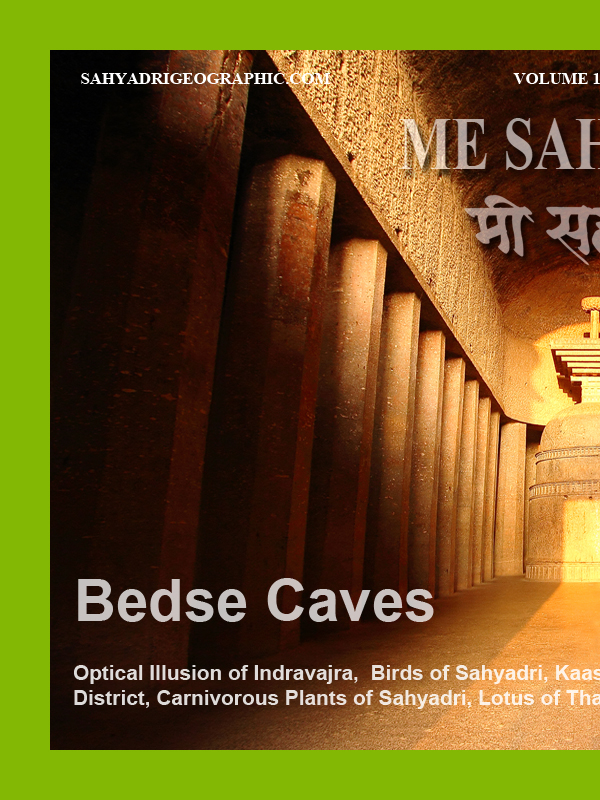 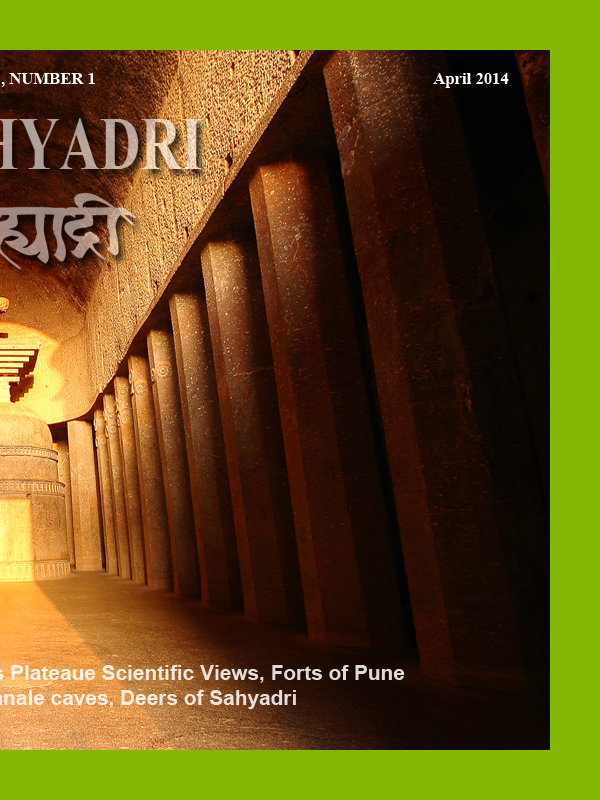 |
| |
| Me Sahyadri – April 2014
|
| |
|
|
या सदरात, सह्याद्रीच्या विविध घटकांबद्दल छायाचित्र व माहिती द्वारे तोंडओळख मांडली आहे.
|
|
This journal introduces various elements of Sahyadri through brief information and photographs.
|
|
|
| |
  |
| The banner has been published here to improve the awareness of the trekkers and tourists visiting the various mountain forts, mountains in north western ghats. Please avoid accidents, by following good outdoor ethics such as no swimming in cisterns at mountain forts, no rock climbing without proper technical equipment and expertise. Please do not adventure, trek with any group or individually without understanding the risks associated. The frequency of the solo trekker fatalities have increased recently. Please strictly avoid solo treks. Please also avoid treks to mountains in large commercial groups, as it leads to damage to biodiversity of these high elevation ecological islands. Please respect the wildlife and biodiversity of the region. This has become more important as the ever increasing human interference is leading to severe damage to fragile ecosystems. Please be aware of the wildlife and biodiversity of the mountains before visiting these mountains. Please follow outdoor ethics. Follow ASI and Forest department rules. The concept of use of symbols for outdoor ethics was conceived and designed by "Sahyadri Trekker Bloggers Group". |
| |
|
|
| |
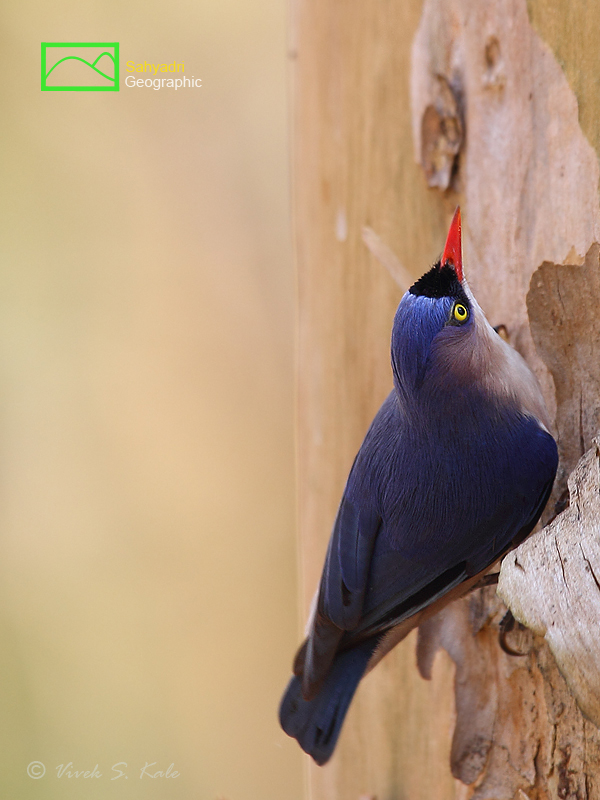 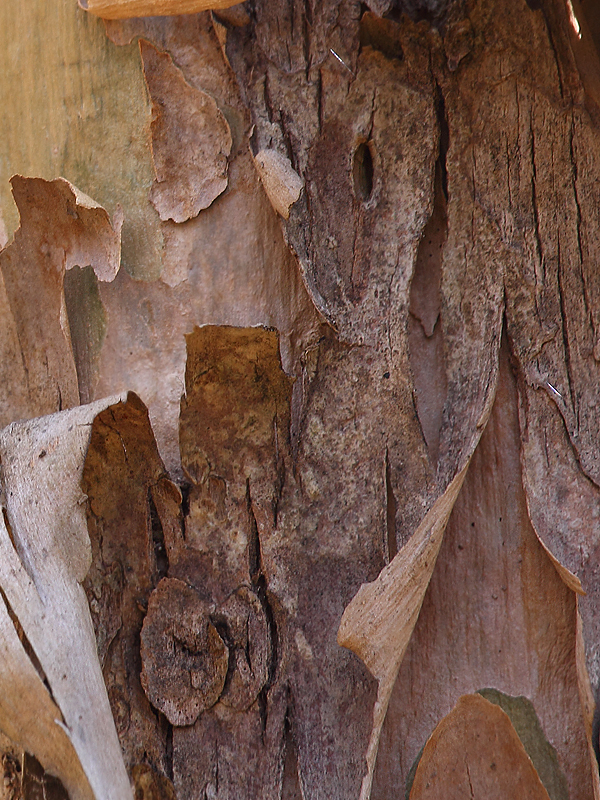 |
| |
| Velvet fronted Nuthatch, Western ghats, India
|
| |
|
|
आपण बालपणी जंगलाबद्दल बऱ्याच गोष्टी वाचतो. फार वर्षांपुर्वी संपुर्ण भारतात जंगल, गवताळ माळ होते. पानगळीची व सदाहरित जंगले शेकडो मैल दुर पर्यंत पसरली होती. प्राण्यांचा व पक्ष्यांचा त्यात मुक्त विहार होता. हळुहळु होणाऱ्या मानवी लोकसंख्येच्या वाढीमुळे जंगलतोड वाढु लागली. सह्याद्रीच्या जंगलात असलेले विविध प्राणी लुप्त होऊ लागले. मखमली नटहॅच किंवा "मखमली झाडचढ" अशा नावाचा एक अजब पक्षी या भारत भर पसरलेल्या जंगलात रहात होता. झालेल्या जंगलतोडीमुळे, आज जंगल बेचक्या बेचक्यात राहिले आहे. कुठे थोडे ओरिसात, कुठे थोडे पुर्वांचलात, कुठे थोडे उत्तराखंडात, थोडे सातपुड़्यात, थोडे दक्षिण सह्याद्रीत असे त्या अखंड जंगलाचे बारके तुकडे झाले. एकाच जातीच्या पक्ष्यांची ताटातुट झाली. "मखमली झाडचढ" चे हे असेच झाले. आज हा पक्षी दक्षिण सह्याद्री, पुर्व घाट, सातपुड़्याचा काही भाग, श्रीलंका व हिमालयाच्या रुंदपर्णी जंगलात आढळतो. उंच झाडांवर, झाडाच्या खोडावरच्या सालीत रहाणारे किडे तो खातो. झाडाच्या बुंध्यावर, फांद्याच्या खालच्या बाजुस तो आपल्या नखांच्या मदतीने सरसर वावरतो. असे करताना बऱ्याचदा तो उलट म्हणजे पाय वर व डोके खाली अशा पद्धतीने वावरत असतो. कपाळावरच्या काळ्या रंगाचा मखमलीमुळे याला इंग्रजीत वेलवेट फ़्रंटेड नटहॅच असे म्हणतात. मराठी भाषा वयाने लहान असल्याने व मराठी भाषाकार जंगलात कधीच न गेल्याने किंवा महाराष्ट्रात जंगल पुर्वीच साफ झाल्यामुळे या पक्ष्याला मराठीत नाव नाही. गुजरातच्या डांग भागात याला झाडचढ असे संबोधतात. चांगल्या जंगलाचा हा एक निदर्शक आहे
|
|
The birds of Sahyadri is a very interesting subject. There are about 10,000 bird species on our planet. Many bird species have become extinct, during the slow evolution of life on the earth. In current era, the human interference in the ecosystems has led to severe stress on bird life all across the globe.
India has about 1200+ bird species which include both resident and migratory ones. About 500+ species are recorded in western ghats. Few of the resident birds of western ghats are not seen anywhere else on the planet, outside western ghats. These are unique species, endemic to western ghats. If the endemic species vanish from western ghats, the species will also vanish from the planet. Slow but steady depletion of forest, fragmentation of habitats, is being sponsored by the state and in turn by us.
The velvet fronted nuthatch is a small bird which survives on the insects and is seen in broad leaved forests of western ghats (Karnataka, Kerala) , Srilanka, Himalayas, and part of eastern ghats. This is one of those birds which have vanished from Sahyadri forests in Maharashtra. For it to survive the forests have to survive. Its habitat is forest full of trees. This bird often is seen clinging upside down on the tree branches looking for the insects in the bark, in forests of South India. It has developed its own niche in the forest.
Today north western ghat forests are ghost forests in patches, already damaged beyond recovery, with loss of many such key indicator flora and fauna species. More detailed reports on forest birds of Sahyadri will be posted in special issue.
|
|
|
| |
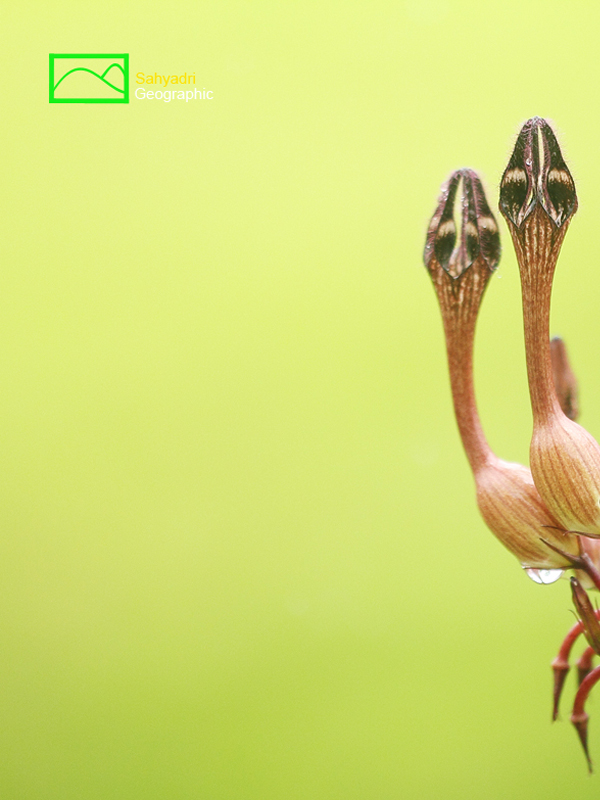 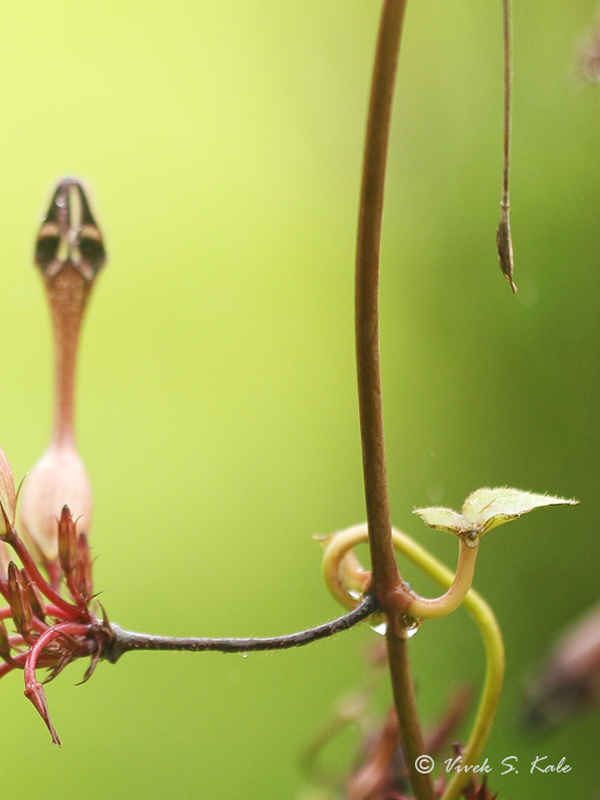 |
| |
| Ceropegia Vincaefolia, Western ghats, India
|
| |
|
|
चित्रातील फुलं मोर खर्चुडी या वनस्पतीची आहेत. मोर खर्चुडीच्या विविध उपजातीतील ही एक वनस्पती आहे. खर्चुडी आपल्या कंदिलपुष्पात लहान किटक व माश्यांना आमंत्रीत करते. माश्यांचा वापर करुन आपले परागीभवन करते. काम झाले की फुल गळुन पडते, व किटकाची फुलातुन सुटका होते. वनस्पती व किटक यांच्या मध्ये आढळणारे हे सामाजिक देवाणघेवाणीचे एक उदाहरण. आपल्याला यातुन बरेच काही शिकण्यासारखे आहे. खर्चुडीच्या बहुतेक जाती दुर्मीळ आहेत. सह्याद्रीत याच्या विविध जाती आढळतात.
|
|
Ceropegia Vincifolia is one of the several species of Ceropegia. Ceropegia species in nature have become rare. The plant has very interesting social behavior. The flower has a unique shape with a tubular chamber connected to the mouth via a tunnel like vertical tube. The insects are attracted by odour. Insects enter the openings provided at the top of the tube. The opening size varies from species to species, thus controlling the size of the intruder. Once the insect enters the tube, it reaches the chamber at the bottom. There the pollina are transferred to the insect. Due to the hair like structure on the inside of the tube walls the insect can not easily escape. After the successful transfer of poliina, the entire flower droops, facilitating the escape of the insect. Thus the plant is indirectly helped by the insects, for its pollination. The insect gets the nectar and it is left out unharmed. Such is the understanding between plants and insects, that human being can learn from such story.
|
|
|
| |
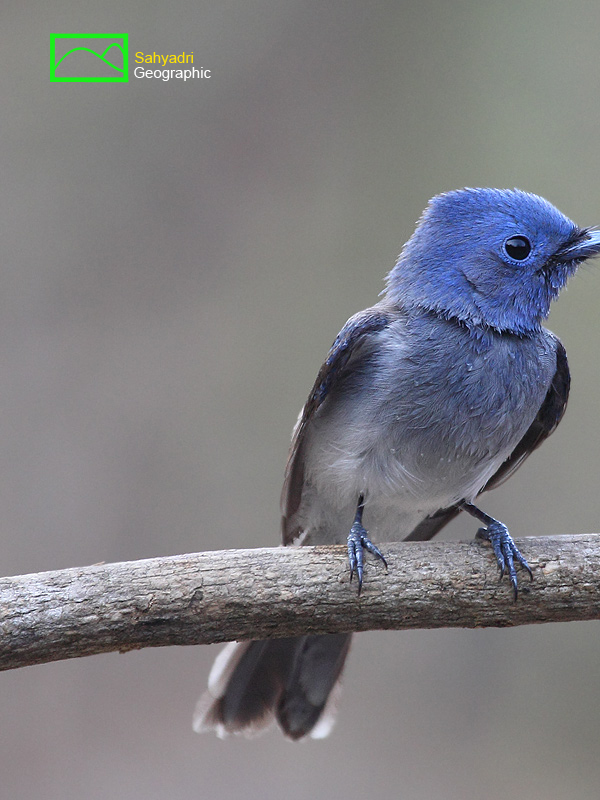 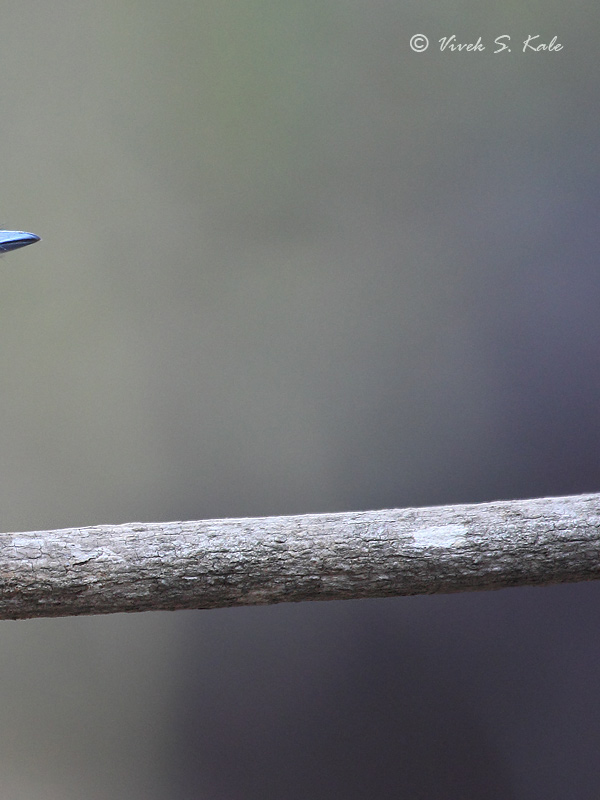 |
| |
| Black naped Monarch FC, Western ghats, India
|
| |
|
|
लहान पण देखणे असे माशीमार पक्षी जंगलात रहातात. जंगलात असणारे किडे व माश्या हे त्यांचे खाद्य होय. भारतात माशीमार जातीचे अंदाजे ३५ प्रकारचे पक्षी आहेत. इंग्रजीत याला फ्लायकॅचर असे म्हणतात. या पक्ष्यांचा मुळ गुण माश्या खाणे, म्हणुन त्यांना माशीमार संबोधतात. याचा अर्थ माशीमारेतर पक्ष्य़ांना माश्या खाता येत नाहीत असा नव्हे. या माशीमारांपैकी काही प्रजाती स्थानिक आहेत. तर काही स्थलांतर करणाऱ्या प्रजाती आहेत. भुत्या (स्वर्गिय नर्तक), निळा मोनार्क, टिकेल निलिमा, राननिळा (सफेद पोटाचा निळा माशीमार), निलगिरी राननिळा(निलगिरी) , रान नारंगी (निलगिरी), हे स्थानिक माशीमार आहेत.
तर हिमालयात प्रजनन करणारे पण हिवाळ्यात सह्याद्रीत स्थलांतर करणारे, माशीमार आहेत. यात निलिमा, तांबुल, करडा पिवळा माशीमार (कॅनरी), काश्मिर माशीमार, तपकिरी माशीमार, निळ्या छातीचा माशीमार, गडद निळा माशीमार, तपकिरी शेपटाचा माशीमार, तपकिरी छातीचा माशीमार अशा प्रजाती आहेत. निलगिरी राननिळा (निलगिरी) , रान नारंगी (निलगिरी), राननिळा (सफेद पोटाचा निळा माशीमार) हे तीन पक्षी सह्याद्रीचे अंतर्जन्य किंवा प्रदेशनिष्ठ आहेत. ते पश्चिम घाटाबाहेर सापडत नाहीत.
|
|
India has about 35 species of flycatchers.
Western ghat has about 16 species of flycatcher birds, some migratory and some resident.
Resident flycatchers include asian paradise FC, black naped monarch FC, tickell’s blue FC, White bellied blue FC, Nilgiri FC (Nilgiri), Black and orange flycatcher (Nilgiri).
Migratory flycatchers include red breasted FC, red throated FC, ultramarine FC, grey headed canary FC, Verditer FC, Blue throated FC, Kashmir FC, Asian brown FC, Rusty tailed FC, Brown breasted FC. Migratory flycatchers breed in Himalayas and winter in western ghats.
All most all these flycatchers are forest birds. They are seen in well wooded regions. Out of 16 flycather species 3 species viz white bellied blue FC, Nilgiri FC, Black and Orange FC are endemic birds of western ghats.
|
|
|
| |
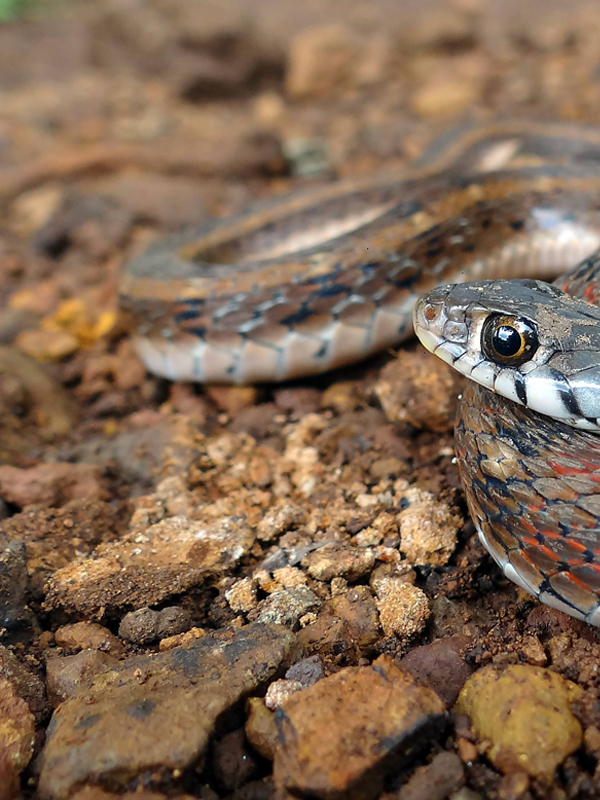 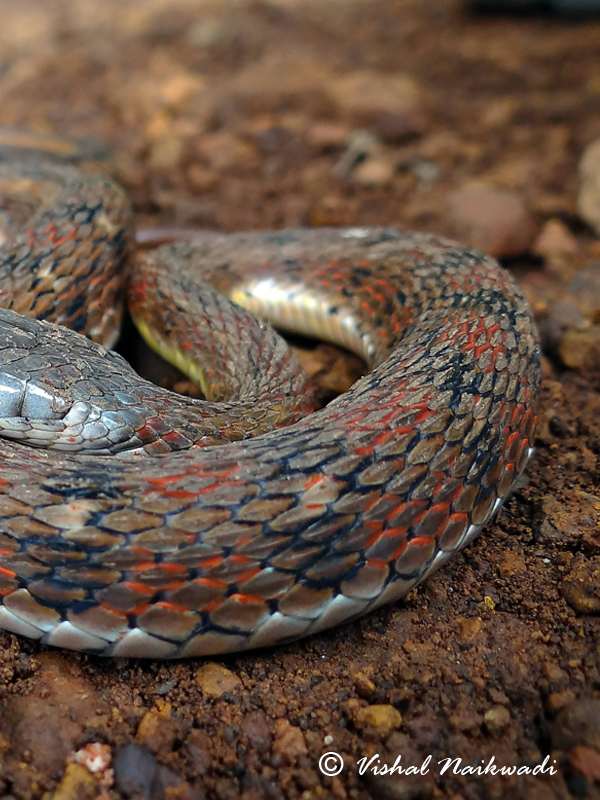 |
| |
| striped keelback, amphiesma stolata, western ghats, India
|
| |
|
|
सापांबद्दल जनमानसात योग्य माहितीचा प्रसार व्हावा असे सद्फ कडवेकर या तरुणास वाटते. सह्याद्रीच्या कुशीत चिपळुण जवळ रहाणारा सदफ खालील लेखात आपले विचार मांडत आहे.
सदफ आपले शिक्षण घेत आहे. तो त्याच्या भागात सर्पमित्राचे काम आवडीने करतो.
साप एक भयंकर प्राणी असुन त्याला ताबडतोब मारले पाहिजे असे अनेकांना वाटते. प्रत्येक साप विषारी आहे, तो डुख धरुन मुद्दामुन माणसाला दंश करतो अशा सापांबद्दल गैरसमजुती आहेत. वास्तविक पाहता फारच थोडे साप विषारी आहेत. विषारी साप मानवाला फार उपयुक्त आहेत. सापाचे निसर्गातले महत्वाचे स्थान आहे.
अवघ्या जगात सापाच्या जाती पोट्जाती धरुन २५०० प्रकार आहेत. त्यापैकी ४०० प्रकार्चे साप विषारी आहेत. भारतात सापाच्या सुमारे ५०० पोट्जाती आहेत. त्यातल्या फक्त ७८ जाती विषारी आहेत. ७८ पैकी २९ जाती समुद्रातल्या आहेत. महाराष्ट्रात साधारणपणे ३२ जातीचे साप आढळतात. उपजाती धरुन ५२ प्रकारचे साप आढळतात. ५२ जातींपैकी १० साप विषारी आहेत. यावरुन असे लक्ष्यात येते की , फारच थोडे साप विषारी आहेत. आपण उगाच "साप साप" म्हणून भुई थोपटत असतो.
प्रत्येक प्रदेशात पाऊस, जमिन व वातावरणाला अनुकुल सापांच्या जाती तेथे आढळतात. सह्याद्री म्हणजे सापाचे नंदनवन. महाराष्ट्रात आढळणारे अर्धे साप फक्त सह्याद्रीत आढळतात. बिनविषारी सापांच्या अनेक प्रजाती आपल्याकडे सहज आढळतात. पण त्यांच्या बद्दलच्या माहितीच्या अभावामुळे, अज्ञानामुळे, भितीमुळे बिनविषारी साप विषारी सापांबरोबर मोठया प्रमाणात मारले जातात. निसर्गाने दिलेली देणगी म्हणजे साप आणी साप वाचवणे फार महत्वाचे आहे. साप कोणत्या अधिवासात रहातात, कोणते वातावरण त्यांना अनुकुल आहे. त्यांना मिळणारी नैसर्गिक शिकार कितपत उपलब्ध होते यावर सापांच्या जगण्याचे प्रमाण ठरवता येते.
चित्रात दाखवलेला अस्सच एक बिनविषारी साप आहे. त्याचे नाव आहे नानेटी, स्ट्रिप्ड किलबॅक.
सापांबद्दल नेमकी माहिती देणारे वेगळे सदर, काही दिवसात प्रकाशित होईल.
|
|
Snakes is a passion for Sadaf Kadvekar, a youth from a small hamlet near Chiplun at the foothills of Sahyadri in Konkan region of Maharashtra. He is a sarpamitra and helps people and snakes around by conducting rescue operations. His passion to save the snakes has given him vital experience about the myths, superstions and misunderstanding about snakes in the region. The following article written by him, with intention of spreading good word about the snakes, may help all of us to save more snakes from getting killed for no reason.
‘Snake is a very dangerous creature and it should be killed at once’. This is a concept in the minds of every human being. ‘Every snake is venomous and it intentionally attacks human being’ is another misconcept in our mind.
Many non venomous snakes are killed by human beings in large numbers along with the venomous snakes, for no reason. Snakes never intentionally attack human beings. The attacks often happen accidentally or due to negligence of human being. In fact very few snakes are venomous. To save the snakes, the knowledge about venomous snakes and non venomous snakes should spread. Snakes have their important role in the ecosystem. Every ecosystem has different species of snakes.
Out of about 2500 species of snakes on our planet, 400 are venomous. In India out of 500 species of snakes, 78 are venomous of which 29 are sea species. In Maharashtra out of 52 species of snakes only 10 are venomous. Majority of snake species are non venomous. Half the species seen in Maharashtra are only seen in Sahyari region.
The photograph shows the non venomous snake, “the striped keelback”. Special thanks to Vishal Naikwadi for the photograph.
The detailed awareness article about the snakes of sahyadri will be published soon.
|
|
|
| |
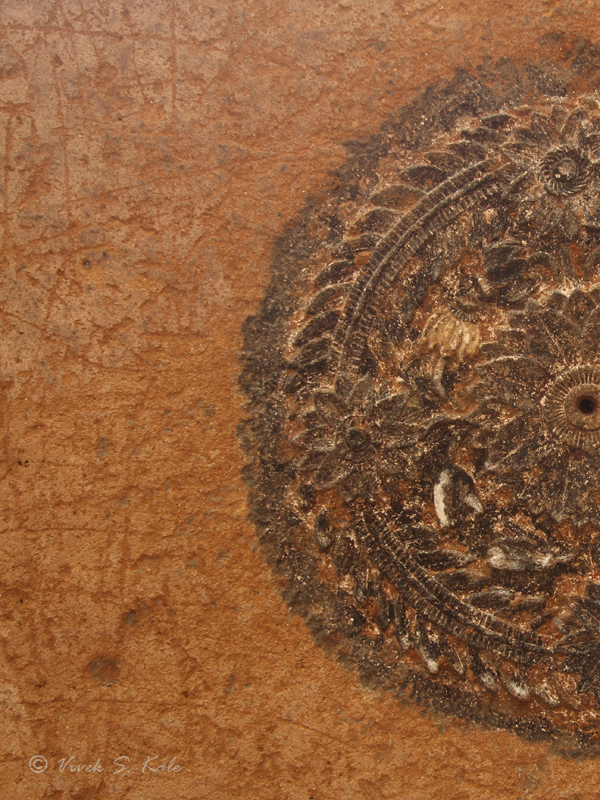 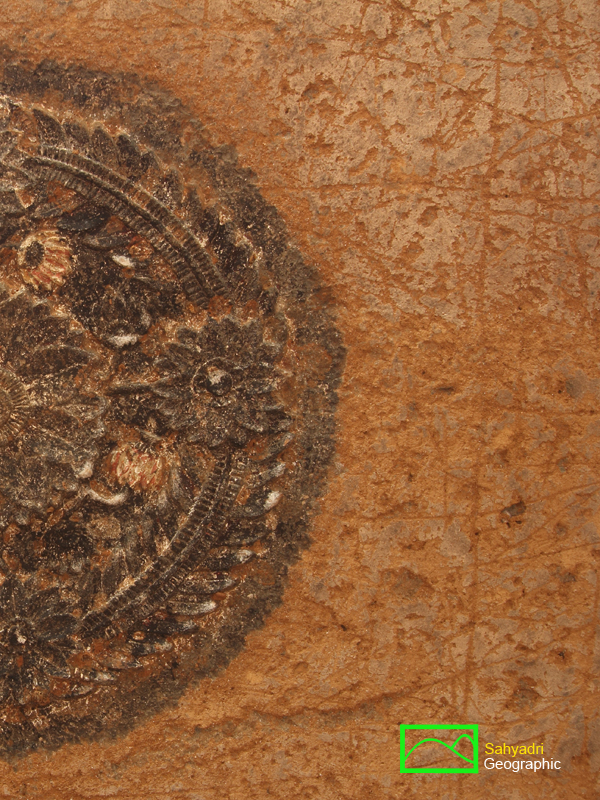 |
| |
| Painted Sculpture on the ceiling of Thanale caves, Western ghats, India
|
| |
|
|
कमळ एक सुंदर मोठे ठसठशीत फुल आपणा सर्वांनाच माहित आहे. कमळाची वनस्पती पाणथळ भागात असते. त्याची पाने व फुले पाण्यावर तरंगतात. चिखलात असलेली त्याची मुळ, कोवळी पाने, त्याचा खोडाचा भाग, बिया हे सर्व खाण्याचे पदार्थ आहेत. कमळाचा सर्वात महत्वाचा गुण म्हणजे त्याची तापमान निय़ंत्रित करण्याची परिसंस्था. फुलाच्या आत तापमान नियंत्रित रहावे असे वाटणाऱ्या व करुन दाखवणाऱ्या, काही वनस्पतींमध्ये कमळाची गणना होते. परागीभवन करण्यास मदत करणाऱ्या किटकांना ऊब मिळावी असे या वनस्पतीस वाटते. या कमळाप्रमाणे माणुस कोणत्या निसर्ग घटकाला ऊब देतो ? कमळाचा अजुन एक गुण म्हणजे याच्या बीजाचे आयुष्य. हजारो वर्षांनंतर सुद्धा याचे बीज रुजते.
बुद्ध धर्माच्या संकल्पनेमध्ये कमळाने एका महत्वाच्या चिन्हाचे स्थान पटकावले आहे. कमळ म्हणजे मन, शरीर व अभिचाराची शुद्धता होय. वस्तुनिष्ठ जगापासुन अलिप्त असण्याची शुद्धता.
हिंदु धर्मात कमळाला सौंदर्य, पावित्र्य, व अचुकता दर्शवणारी खुण मानली जाते.
कमळाचे हे चित्र ठाणाळे गावाजवळ असलेल्या डोंगरातल्या बुद्ध कालीन लेण्यांमध्ये छतावर कोरले आहे. पुणे व रायगड जिल्ह्याच्या सीमेवर सह्याद्रीच्या कड़्यावर या लेणी आहेत. पुरातन चौल बंदरापासुन दक्षिणेच्या पठारावर असलेल्या बाजारपेठांकडे जाणाऱ्या मार्गावर ही लेणी आहेत. लेणी दुर्लक्षीत आहेत. सरकारचे लक्ष्य नाही. लेण्याचा काही भाग गेल्या काही वर्षात कोसळलेला आहे. त्यात बऱ्याच कोरिव वास्तु दबल्या गेल्या आहेत. लेणी कोसळण्यापासुन वाचवता येतील का ? त्यासाठी प्रगत देशांची मदत घेता येईल का ? असे बरेच प्रश्न मनात गर्दी करतात.
कोकणातले स्थानिक युवक येथे येतात. आपली नावे भिंतींवर, येथल्या स्तुपांवर रंगवतात.
असे हे विद्रुपीकरण, सरकार चे दुर्लक्ष्य पाहुन फार वाईट वाटते. कमळाचे चांगले गुण माणसाने समजुन घ्यावेत, कमळाप्रमाणे निसर्गाशी मिळते जुळते घ्यावे अशी प्रार्थना.
|
|
Lotus is known to all of us as a symbol.
Lotus is called as “Nelumbo nucifera” in science. It is an aquatic plant.
It is a national flower of India. Its roots, flowers, young leaves, seeds are edible.
The life of lotus seeds is very long, more than thousand years.
Lotus has another interesting character. The plant maintains the temperature inside its flower between 30-35 deg C, to attract the cold blooded insect pollinators.
In Budhism, lotus represents purity of body, mind and speech. As it grows from mud, floating on the water it remain clean and pure.
In Hinduism lotus is a symbol of perfection, beauty, purity and elegance.
The iconic painted sculpture on the ceiling of the Buddhist caves, carved around 2200 years back depicts the very purity of mind. Thanale caves are located in the western ghat ridge bordering Pune and Raigad district. Caves are located on the route which connects ancient Chaul port to ancient commercial centers of Deccan plateau. Today the sculpture and the caves are in bad shape slowly turning in to ruins due to apathy of state. There is no caretaker of the caves. A part of caves have collapsed in last 30 years period, with loss of some very interesting sculptures. The visitors often further damage the caves, due to lack of knowledge about its significance. The walls are paint marked by local village youth with their names, indicating how much love they have for their girlfriends.
Let the purity of lotus inspire the human beings to purify their minds away from the ghastly materialistic desires, in turn protecting the very mother nature which feeds them. I have translated the sculpture by using a handmade sketch, just to further impress how beautiful it is.
|
|
|
| |
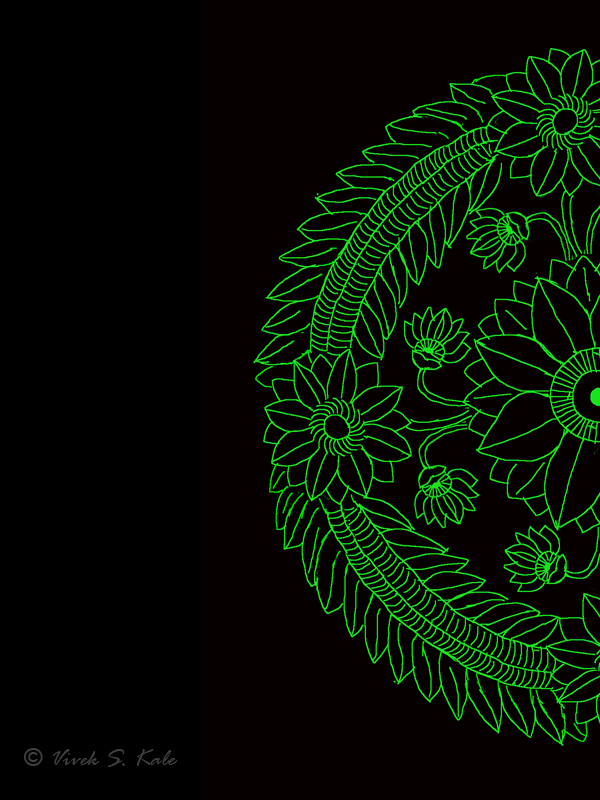 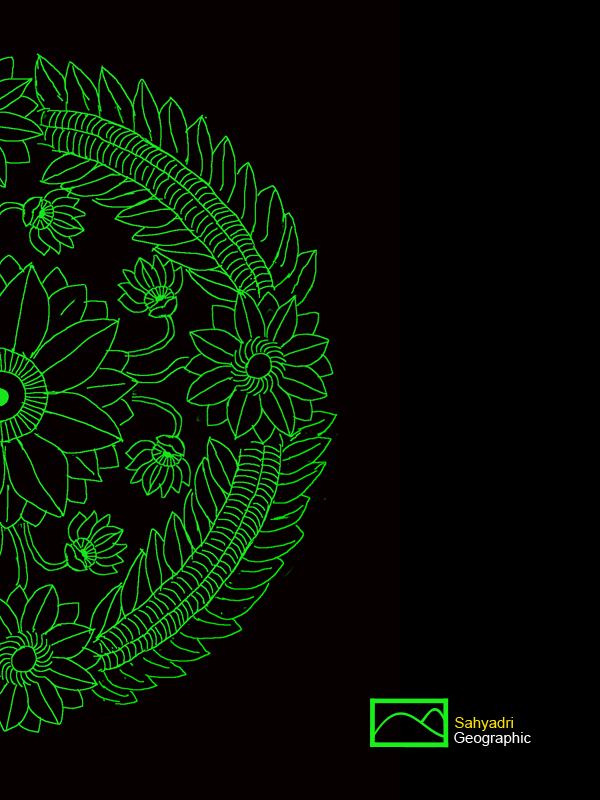 |
| |
| Sketch of design of Painted Sculpture on the ceiling of Thanale caves,Western ghats, India |
| |
|
|
| |
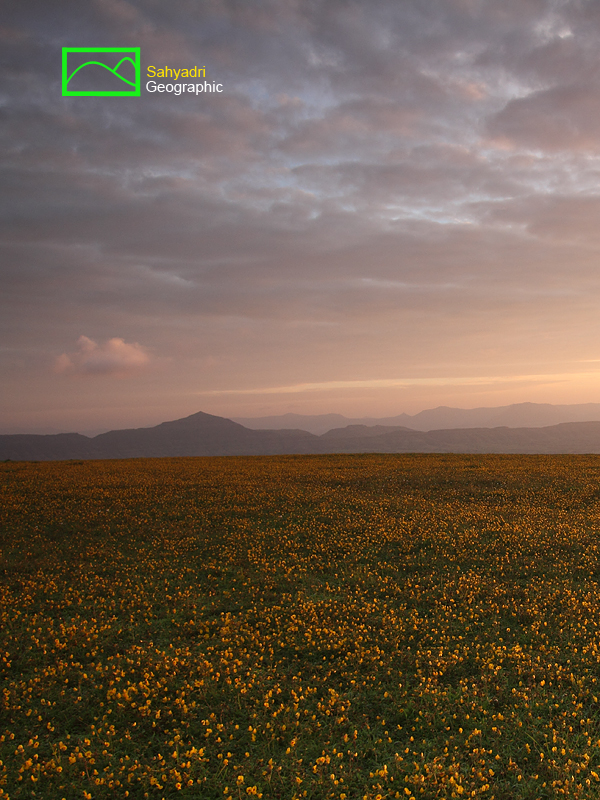 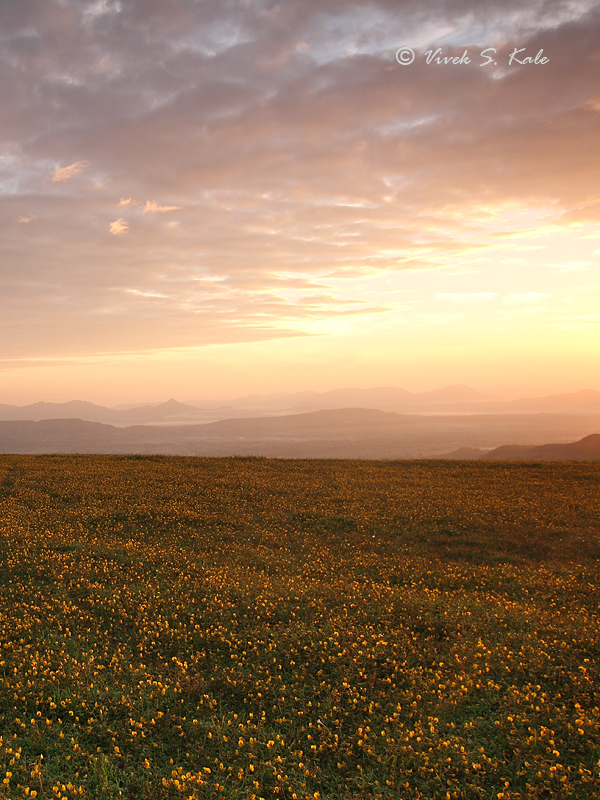 |
| |
| Smithia Hirsuta,near Kaas plateaue, Western ghats, India
|
| |
|
|
कास च्या सड़्याच्या संरक्षणाचे प्रयत्न होत असताना, आजुबाजुच्या डोंगर उतारांवर, व पठारांवर मानवी अतिक्रमण होत आहे. काळाबरोबर स्मिथियाने सजलेले पठार लुप्त होणार.
सड़्यावर पावसाळ्याच्या शेवटी वैविध्य पुर्ण वनस्पती दिसतात. बऱ्याच वनस्पतींना फुले येतात. वातावरणातील बाष्प, पाण्याची पातळी, जमिनीतला मातीचा थर व सुर्यप्रकाशाची तीव्रता, अशा व इतर घटकांवर अवलंबुन असलेल्या वनस्पतींचे साम्राज्य सड़्यावर दिसते. १) मोठे धोंडे, २) उथळ झरे, ३) उथळ पाण्याची डबकी, ४) खोल पाण्याची रांजणकुंडे, ५) उथळ माती असलेली जमिन, ६) खोल माती असलेली जमिन, ७)उतार जमिन, असे विविध लहान अधिवास येथे दिसतात. प्रत्येक अधिवासात वेगवेगळ्या वनस्पती दिसतात.
|
|
Kaas plateau is known to most of us. It is a rich hotspot with a special ecosystem. The ecosystem with mocro habitats of plants on this lateritic plateau is extremely rare. The very specific location of plateau on the deccan plateau, its altitude, at a specific distance from western ghat ridge, the shapes of geological structures in the region including the high rise mountains around Mahabaleshwar, indirectly control the level of mist, rainfall here. There are various types of microhabitats. The rocks on the lateritic plateau have lost the soft elements, and what we see is a rock surface porous in nature with very little nutrients.
The lateritic plateaus have various sub-habitats. In these subhabitats various species bloom. A mosaic is seen on such plateau with various species of flowering plants. The typical examples of these sub habitats include, a) Loose rocks/boulders (species such as Utricularia striatula, Cheilanthus farinose etc), b) Shallow Streams (e.g.Eriocaulon dalzellii) c) Shallow water puddles (e.g. Aponogeton satarensis, Eriocaulon tuberiferum etc) d) Deep water holes (e.g. Nymphoides) e) Deep Soiled depressions (Impatiens lawii etc) f) Shallow soiled depressions (Smithia species., Habenaria species etc) g) Rocky Slopes (Utricularia species) h) Very Deep Soil. A mosaic of these species is seen depending up on the local micro condition of the land.
The habitat of these plants is very fragile. With the incursion of visitors, the external species weeds, are likely to enter in the habitat. Some of the external elements entering the system, are gaseous pollutants, plastic, external soil coming with tyres and shoes.
Though the Kaas plateau is protected to certain extent by state, the hills around kaas on the way from Satara to Kaas plateau such as shown in the image are facing the human interference. The carpet of smithia Hirsuta will be lost in the future.
|
|
|
| |
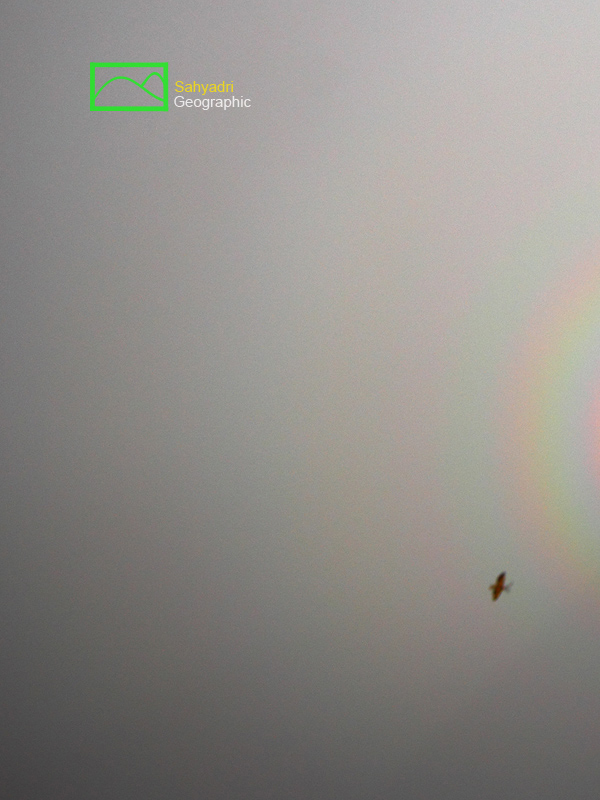 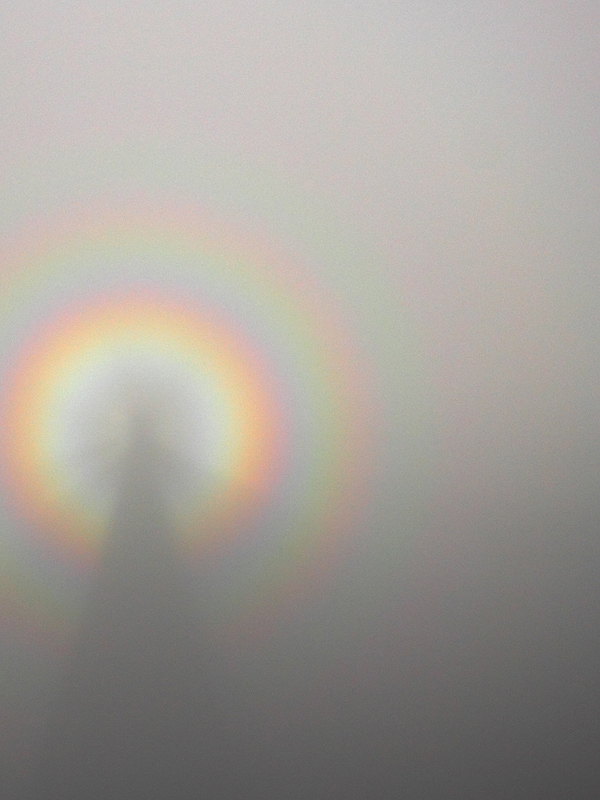 |
| |
| Swift in Indravajra at Harishchandragad, western ghats, India
|
| |
|
|
आभाळात दिसणारे इंद्रधनुष्य न पाहिलेला माणुस शोधुन सुद्धा सापडणार नाही. इंद्रधनुष्याच्या रंगात असणारी किमया सर्वांच्या मनात आनंदाचा तरंग फुलवते. पावसाळ्यात आपल्या एका बाजुला सुर्य व दुसऱ्या बाजुस पाउस अशी स्थिती झाल्यास क्वचित इंद्रधनुष्य दिसते. इंद्रधनुष्य हे पाण्याच्या लहान थेंबात होणाऱ्या प्रकाशाच्या परावर्तन व वक्रिभवन यामुळे दिसते. सफेद रंग या प्रक्रियेत ७ रंगात विभागला जातो. त्यांच्या तरंग लांबीतल्या फरकामुळे आपल्याला लाल ते जांभळा असे रंगाचे पट्टे दिसतात. इंद्रधनुष्या सारखीच पण दिसण्यास वेगळी अशी अजुन एक किमया आहे ज्याचे नाव आहे इंद्रवज्र. इंद्रवज्र संपुर्ण गोल दिसते. त्यात ३ किंवा अधिक रंगीत पट्ट्यांचे संच दिसतात. आकाराने लहान असले तरी ते पाहिल्यावर पाहणारा अचंभित होतो. उंच पहाडावर विशिष्ठ परिस्थिती जुळुन आल्यास इंद्रवज्र दिसते. देवाच्या डोक्याभोवती कल्पित प्रभाचक्रा प्रमाणे ते भासते. इंद्रवज्रात फक्त रंगच दिसत नाहीत. त्यात आपल्याला आपली सावली मध्यभागी दिसते. आपल्या सावली भोवती दिसणाऱ्या या प्रभे मुळे आपण देवासमान असल्याचा पाहणाऱ्यास आभास होतो. देव दुसरा कोणी नसुन आपल्यातील चांगल्या प्रवृत्तींचा सारांश आहे असे मन समजते. शास्त्रीय दृष्टिकोन असणाऱ्यास इंद्रवज्र एक गमतीदार पण गहन कोडे वाटते.
पुढच्या पावसाळ्यात रतनगडावर मोहिमे दरम्यान पुन्हा धुक्याने वेढले. धुके एवढे दाट होते, की श्वास घेणे अवघड जात होते. गुहेतल्या आतल्या भागात जेमेतेम कोरड़्या भागात रात्रभर श्वास घेतला. बाहेरच्या धुक्यात, रात्री चक्क इंद्रवज्र उमलले. पुढच्या सदरात आपण समजवुन घेऊयात कसे ते !
|
|
The expedition to see and photograph the circular rainbow (Indravajra) in Western Ghats took us to Konkan cliff of Harishchandragad. Being one of the geological wonders of Western Ghats, the cliff has amazing structure. It is a vertical precipice with overhang. The overhang is about 10 meters. The height is 3900 feet (1300 meters) above msl. There is a semicircular valley on the western end of the mountain having vertical fall depth of 1200 feet. The horizontal arc length of the cliff top edge is about 1 km. In the pre and post monsoon season, a strange natural phenomenon called as glory or circular rainbow can be seen from this cliff edge. The phenomenon is similar to rainbow. However its scientific principle and structure is entirely different from that of rainbow. The normal rainbow is called as “Indradhanushya” in Marathi. The glory or circular rainbow is called as “Indravajra” in Marathi. In western world the spectacle is named the “spectre of the Brocken” after the peak in the Harz Mountains of Germany, where it is often seen.
The optical illusion is purely a natural phenonmenon. In another expedition we were caught on another fort in the region called Ratangad. The weather was unbreathable. The heavy moisture present on the top made survival difficult. Thanks to a cave where we could find the small section with dry air, that we could breadth whole night. The fog was intense and triggered us to conduct the experiment to create the indravajra artificially. An interesting experience of creating the Indravajra will be published soon in a separate article.
|
|
|
| |
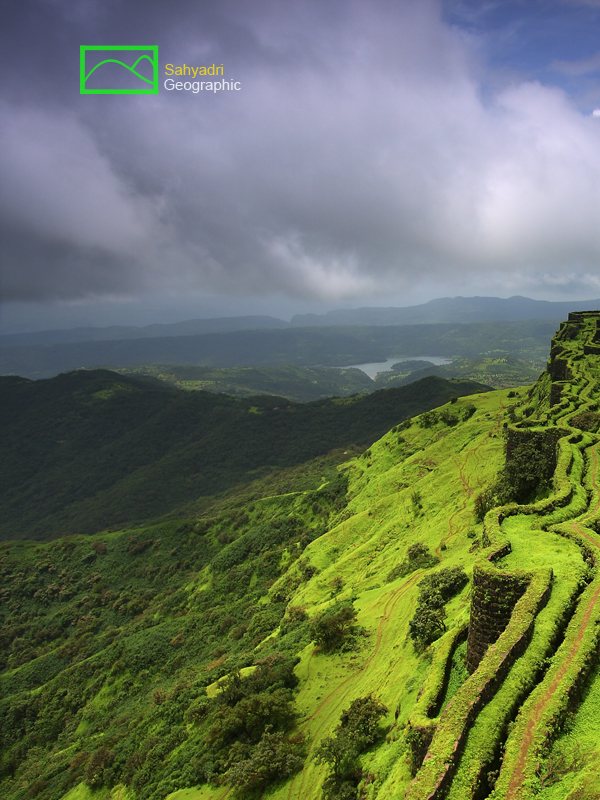 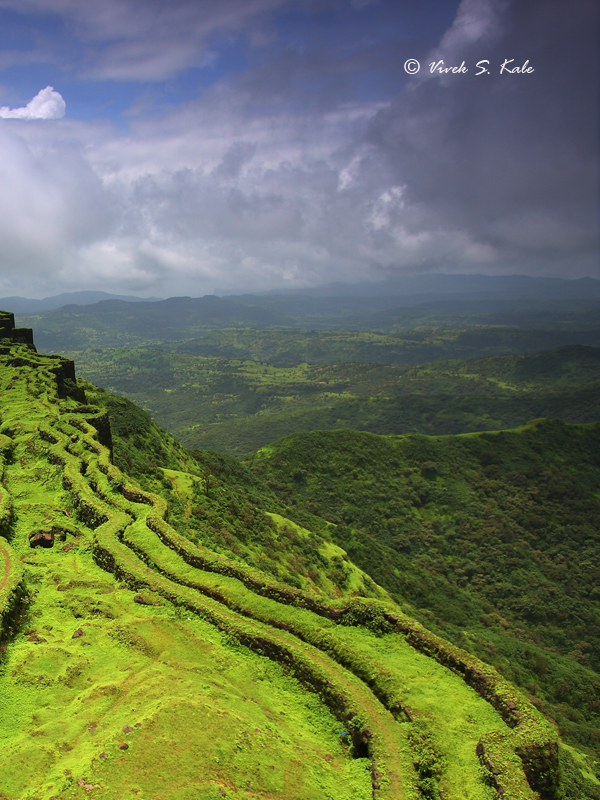 |
| |
| Sanjeevani Machi, Rajgad, Western ghats, Maharashtra, India
|
| |
|
|
आपल्या सह्याद्रीत महत्वाच्या ऐतिहासिक घडामोडी घडल्या. सतराव्या शतकात, छत्रपती शिवाजी महाराजांनी येथील दुर्गमतेचा, योग्य उपयोग केला. तसे करताना त्यांनी निसर्गाला धक्का लागु दिला नाही. त्यांनी निर्माण केलेल्या राष्ट्रप्रेमाचे स्फुरण आजसुद्धा आपल्याला त्यांच्या चरित्रातुन मिळते. अशा सह्याद्रीच्या ऐतिहासिक महत्वाची जरी बहुसंख्य नागरिकांना जाण असली तरी, त्याच्या भौगोलिक महत्वाची मात्र बहुसंख्य नागरिकांना जाण नाही. ज्या सह्याद्रीतुन अर्ध्या अधिक महाराष्ट्राला जलपुरवठा होतो, त्याचे पावित्र्य राखणे हे महत्वाचे आहे. येथील, डोंगरांचे, त्यातील स्फुरण देणाऱ्या पुरातन वास्तुंचे, इथल्या प्रत्येक दगडाचे, गवताच्या प्रत्येक पात्याचे, झाडांच्या प्रत्येक मुंळाचे, त्यांवर जगणाऱ्या प्रत्येक वनजीवाचे आपण ऋणी आहोत.
|
|
The north western ghats in state of Maharashtra, underwent lot of political and commercial upheaval during the past. It was seventeen century when a major political battles were fought between the invaders and King Shivaji in western ghats. The Sahyadri range has today some of the remains of the forts and battlefields from the past, from this era. We today enjoy the democratic freedom, which King Shivaji imagined and founded in 17th Century. Even today many get inspired by his nationalism. When we follow the history of the north western ghats, we overlook the geography, flora and fauna of the region. I have tried to generate the cross learning medium here.
|
|
|
| |
 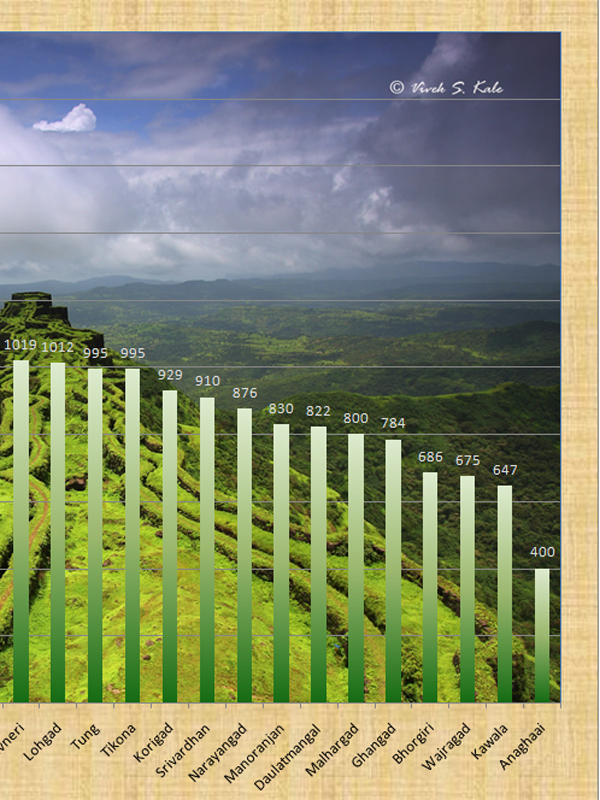 |
| |
| Altitude of mountain forts in Pune district,Western ghats, India
|
| |
|
|
पुणे जिल्ह्यात अंदाजे २८ डोंगरी किल्ले आहेत. (तिसरीच्या भुगोलाच्या पुस्तकात मात्र, फक्त ८ किल्ल्यांचा उल्लेख आहे. लहान मुलांना ज्यांना अगणित कार्टुन पात्रांची विचित्र नावे तोंड्पाठ असतात, त्यांना ३०-३२ किल्ल्यांची नाव न शिकवता फक्त ८ किल्ल्यांची नावे शिकवुन मुलांच्या क्षमतेचा अनादर आपली शिक्षण पद्धती करते आहे.)
आलेखात दाखवल्याप्रमाणे, २८ पैकी ४ किल्ले फार उंच आहेत. त्यांची उंची १३०० मीटर पेक्षा जास्त आहे. एखाद्या ठिकाणाची समुद्र्सपाटीपासुन ची उंची, हा तेथेल्या वातावरणाचा एक महत्वाचा प्रमापक आहे. उंची १२०० मीटर वर असल्यास तेथे विशिष्ठ वनस्पतीं आढळतात.
एखाद्या किल्ल्याचे संवर्धन करणे, म्हणजे तेथील सर्व जमिन साफ करणे, तेथील सर्व वनस्पती काढुन टाकणे असा एक गैरसमज सर्वत्र पसरत आहे. ऐतिहासिक ठिकाणाच्या ऐतिहासिक महत्वापेक्षा तेथील नैसर्गिक संपदेचे महत्व कित्येक पटिने जास्त आहे, हे समजुन घेणे महत्वाचे आहे. संवर्धन करणाऱ्यांनी पुर्ण माहिती शिवाय साफसफाई करणे चुकीचे आहे. पुणे जिल्ह्यातील बऱ्याच किल्यांवर अत्यंत दुर्मिळ वनस्पती (गवता पासुन मोठ्य़ा झाडांपर्यंत आहेत).
उदाहरण म्हणुन पुरंदर घेऊ यात. आज तेथे लष्करी ठाणे आहे. पुरंदराची उंची, तेथील कोरडी हवा, कमी पर्जन्यमान यामुळे तेथे काही दुर्मिळ वनस्पती आढळतात. त्यातल्या काही वनस्पती इतरत्र जवळपास फक्त हिमालयात, अफगाणिस्तानात आढळतात. पुरंदरावर आढळणारी "शिंदळ माकडी" वनस्पती अत्यंत दुर्मिळ आहे, लुप्त होण्याच्या मार्गावर आहे.
|
|
Due to the advances in social media, there is a sudden spurt in mobilization of groups who advocate the conservation of monuments, specifically the forts of Sahyadri, in Maharashtra.
In a typical approach the mountain tops are cleaned off any vegetation.
Due to lack of knowledge amongst the common man, about the biological significance of the rare endangered plants, the species are under threat.
Most of the mountain forts are actually islands of high altitude land, surrounded by a sea of low altitude hills and land.
In this series I am putting forward some important geospatial parameters about the mountain forts of Pune district, with the list of botanically important species found on these forts.
In the chart, above you can see that there are about 28 mountain forts in Pune district. The altitude of these mountains vary. Also the position of these mountains with respect to the main western ghat ridge is different.
Altitude is a specific parameter. Above 1000 meter altitude the flora and fauna changes. The 4 top mountain forts, namely Sinhagad, Rajgad, Torna and Purander are amongst the top 40 high rise mountains of western ghats. These hill tops have special vegetation. Purander for example has plant species such as Frerea indica, which is endangered species. Some of the species which are seen on Purander can only be seen nearest in Himalayas and Afganistan. Purander is important botanical place not only because of its altitude but also because of the far distance of this fort from western ghats ridge as compared to other 3 forts. The average rainfall is less there as compared to other 3 high rise forts of the region. This also does not mean that other forts in the region which are of lower altitude less important botanically. There are other parameters apart from altitude that matter, which we will see in next series.
|
|
|
| |
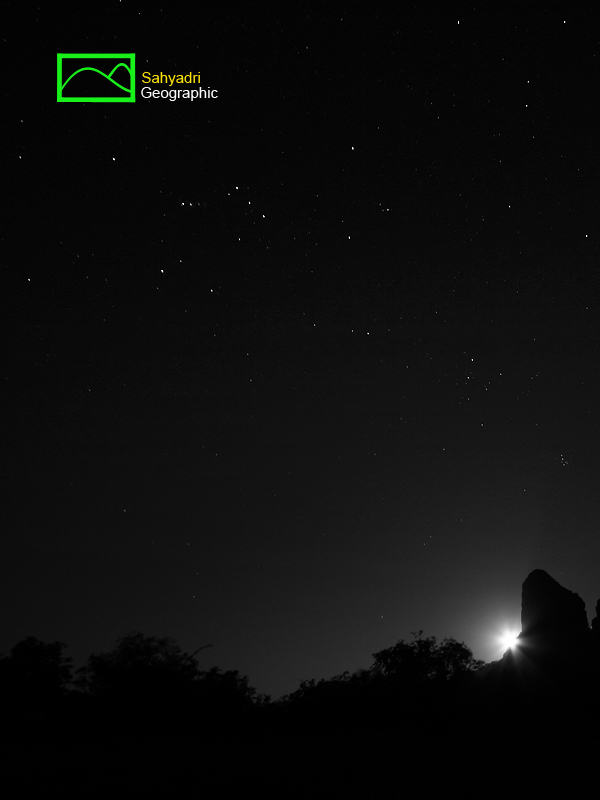 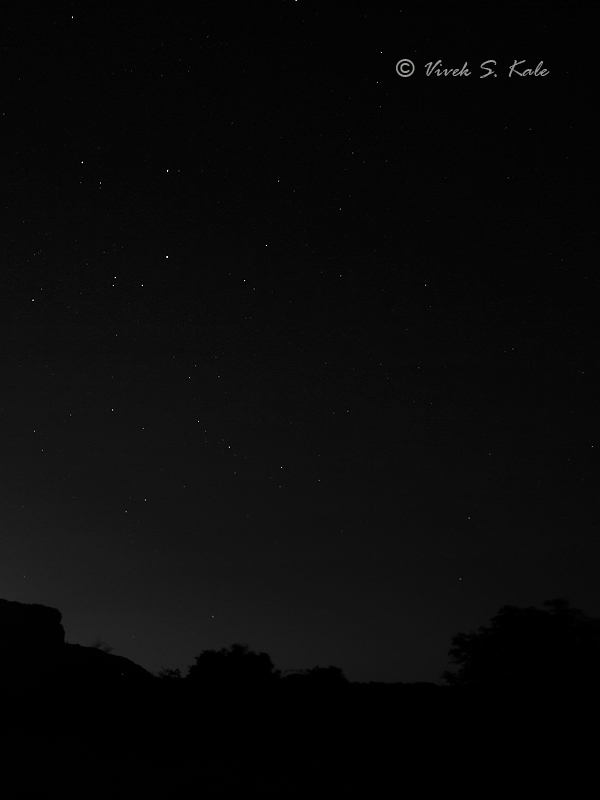 |
| |
| Telbaila wall, western ghats,India
|
| |
|
|
पहाटे गावातला कोंबडा आरवायच्या आधीच, जाग आली. रात्र भर हजेरी लावलेल्या चंद्राची अस्ताची वेळ जवळ आली होती. अजुन रातवे जागे होते. वाऱ्याचा वेग वाढला तसे रानावरचे गवत सळसळु लागले. चंद्र मावळताच अंधार दाटु लागला. सोनेरी गवताची झळाळी गायब झाली. असंख्य तारकांनी आकाश व्याप्त केले. त्यांच्याकडे असे करायला फारसा वेळ नव्हता. तासाभरात पुर्वेला तांबड फुटु लागल. पश्चिमेला आकाश लाजुन फिकट दुधट गुलाबी झाल. सुर्य उगवताच त्याने वाऱ्याला सळो कि पळो केल. पुन्हा रानावरची गवती सोनेरी जर चमकु लागली. आता अशी सोनेरी माळरान फारशी राहिली नाहीत. सोनेरी गवतावरच्या ससाण्यांच पुढे काय होणार देव जाणे. माळावरच्या करवंदीने असे किती साथीदार आतापर्यंत गमावले असतील ?
|
|
The grassland around us was lit beautiful golden, in the moon light. The moon was about to set. It was when we realized that how every night is different. The darkness started prevailing as the moon came close to set against the Telbaila wall. While it was about to set, th eastern sky was lit with the shower of meteorite. We could see the colors in the streaks clearly after the moon set at around 4 am. Entire sky was lit with stars and occasional meteorite streak. It did not last long. At dawn the eastern skies were lit again, this time with a pink diffused light. The sun rose, with it came the golden rays. The rays lit the entire grassland golden. The wind blew this time swinging the grass merrily. Nowadays it is very difficult to find the natural grasslands. I wonder what will happen to the harriers that glide in the sky few meters above the grass.
|
|
|
| |
 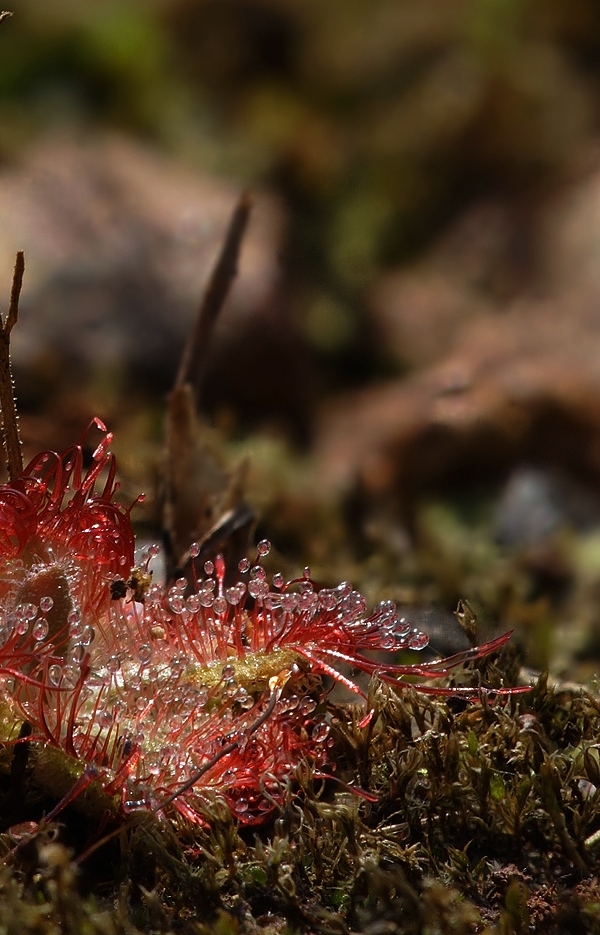 |
| |
| Drosera burmannii ( दवबिंदूं ), Western ghats, India
|
| |
|
|
समजा आपण एक उडणारा छोटा किडा आहोत. गवताच्या गालिच्यावरुन भरारी मारत फुलांमधील रस गोळा करत उडताना अचानक, तुम्हाला आकर्षक चकाकणारे मध, द्रुष्टित येते. मध आकर्षक मध चव घेण्यास खुणावते. अत्यानंदाने तुम्ही त्या दिशेने झेपावता. जवळ जाताच मन्त्रमुग्ध करणारा सुगन्ध तुम्हास बेहोश करतो. स्वर्गच जणु. एवढे दिवस आपणास हा स्वर्ग का सापडला नाही ? असा एक खुळा प्रश्न पडतो. मोह न आवरता तुम्ही त्या मधुकणांवर उतरता. मध चवीष्ट वाटते. घट्ट चिकट मधात तुमचा एक पाय अडकतो. पाय ओढता ओढता, दुसरा पाय चिकटतो. काही कळण्याच्या आतच, तिसरा व चौथा पाय अडकतो. गोड मधात उगाच उतरलो असे वाटू लागते. जीवाची कासावीस सुरु होते. धडपडीत पंखसुद्धा मधात फसतात. थोड्या वेळात वनस्पती तुम्हाला घेरते. अंगात जळजळ सुरु होते. जीवंत रहाण्याची आशा मावळते. तुम्ही जर नशिबवान असाल तर गुदमरुन लवकर मराल पण नसाल तर ताटकळत वेदना सहन करत मराल. हि आहे घातक दवबिंदू वनस्पतीची मायावी दुनिया. वरिल घटनाक्रम एखाद्या किड्या मुंग्यांच्या भयाणपटातील आहे असे वाटत असले तरी हि सत्यपरिस्थिती आहे. |
|
Drosera burmannii ( दवबिंदूं ) is a small tropical sundew. It was first described by Johannes Burman 18th Century botanist, but the species was not formally published until 1794 when Martin Vahl named it in honor of Burman as Drosera burmanni. It is one of the compact species in the carnivorous plant genus Drosera of size, only 20-25 mm in diameter (roughly of the size of one Indian rupee coin). Drosera burmannii ( दवबिंदूं )traps the insects very fast and its leaves can curl around the prey insect in few seconds, compared to the minutes or hours it takes other sundews to trap the prey. Drosera burmannii is an herb that produces short stems and leaves in a rosette. (a rosette is a circular arrangement of leaves, with all the leaves at a particular height.) Tiny creamy white flowers are produced in groups on 6–15 cm tall racemose inflorescences, (An inflorescence is a group or cluster of flowers arranged on a stem that is composed of a main branch.). |
|
|
| |
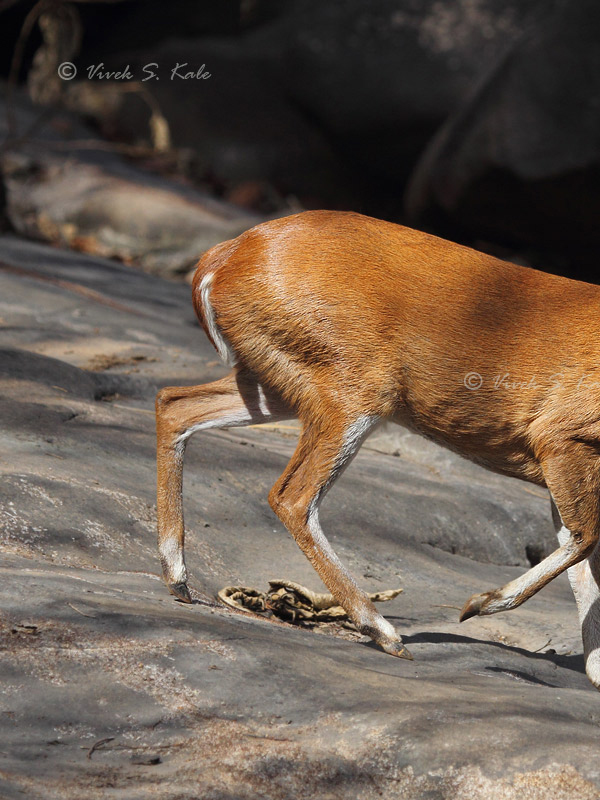 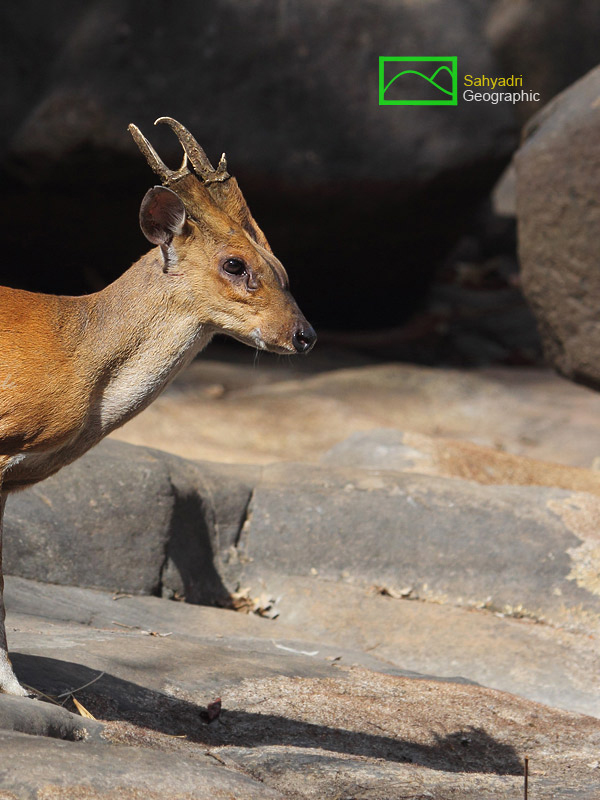 |
| |
| Barking deer, western ghats, India
|
| |
|
|
आपल्या भारतात अंदाजे १६ जातीची हरणे आढळतात. त्यातील ७ जातीची हरणे, आपल्या सह्याद्रीत आढळतात. चौशिंगा, चितळ, सांबर, नीलगाय, चिंकारा, करडा, व पिसोरा ही हरणे सह्याद्रीत आढळतात. चित्रात दाखवलेला करडा जंगलात एकटा किंवा दुकटा आढळतो. कुत्र्या सारखा भुंकतो म्हणुन त्याला इंग्रजीत बार्किंग डीअर असे संबोधतात. अंदाजे ६० से.मी. उंची असलेला करडा, दाट जंगलात रहातो.
|
|
India has 16 species of deers and antilopes put together. Black bucks, Chiru, Chinkara and Goa are species of antilope family. Chowshinga, Blue bull are species of Bovinae family. Spotted deer, Barashinga are the species of Cervinae family. Barking deer is a species of Muntiacinae family. Mouse deer is a species of Tragulidae family. KasturiMrug is a species of Moschidae family.
Out of these 16 species, 7 species namely Chowshinga, Bluebull, spotted deer, Sambar, Barking deer, Mouse deer, and chinkara are seen in western ghats. Barking deer is shown in the photograph. The barking deer is seen in the forest. The deer barks like dog hence it is called as barking deer.
|
|
|
| |
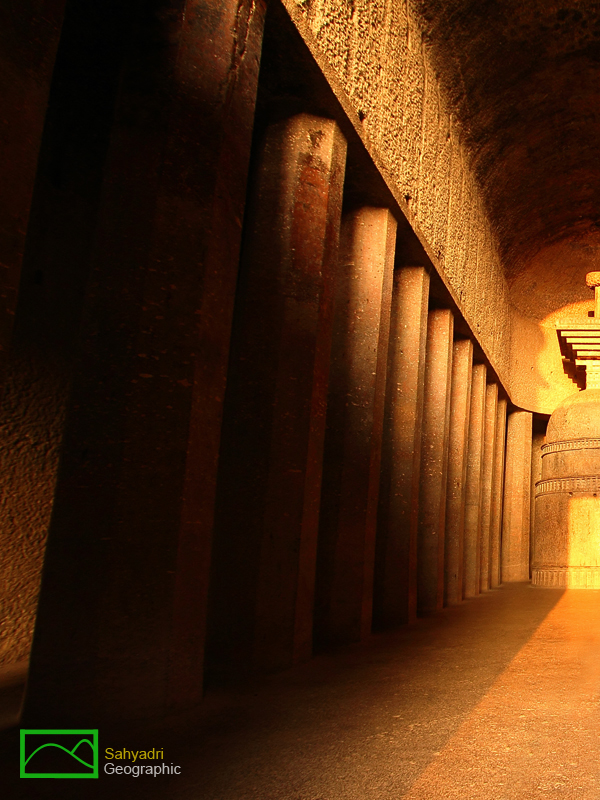 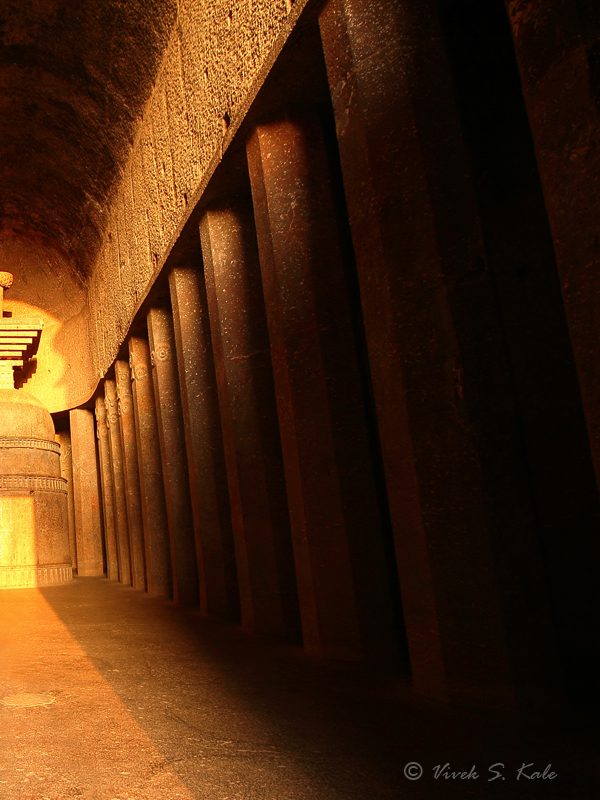 |
| |
| Divine Light, Bedse Caves, Western ghats, India
|
| |
|
|
सुंदर सुर्यप्रकाशाने न्हावुन सकाळ तयार झाली होती. तिरप्या सुर्यप्रकाशात तेजस्वी लाल फुलांनी नटलेल्या सावराच्या वृक्षांनी डोंगर प्रफुल्लित झाला होता.
रात्रभर साठवुन ठेवलेला बोचरा गारवा पाषाणी रमला होता.
सोनचाफ्याचे जमिनीवर पडलेले फुल अजुन ही आपला सुगंध सोडत नव्हते.चैत्यगृहाच्या दारातुन व त्या वरच्या खिडकीतुन तांबुस मंद प्रकाश आत आला.
हवेतल्या हलत्या धुक्यामुळे तो मंद प्रकाश मेणबत्तीच्या प्रकाशासारखा बिचकत होता.
दुर क्षितिजावर डोंगरामागुन सुर्य झरझर वर सरत होता. त्याचा लाल रंग पिवळा सोनेरी झाला तसा चैत्यगृहात सोनेरी उजेड पसरला. स्तुपाच्या मागील पटलावर चैत्यगृहाच्या बाहेरचे स्तंभावरचे कलश आपली ओळख देऊ लागले. स्तुपावरचे लाकडी फुल जणु उमलले.
सुर्याच्या सोनेरी रथाचे पडघम मनात ऐकु येऊ लागले. रविंद्रनाथ टागोरांनी लिहिलेल्या कवितेतल्या विचारांची अनुभुती मिळाली. अनुभुती मिळण्यासाठी मला बरीच धडपड करावी लागली. हे छायाचित्र काढण्यासाठी, एकुण पन्नास एक तास खर्च करावे लागले. बंगळुरच्या श्रीहर्षा ने केलेले मार्गदर्शन, टागोरांच्या कवितेतुन मिळालेले स्फुरण, उपयोगी ठरले. दहिभाते काकांनी जिवापाड जपलेली लेणी आणी एकुणच मिळालेल्या अनुभुती बद्दल पुढिल काही दिवसात; आपण सविस्तर लेखात जाणुन घेऊ.
|
|
Oh Sunlit Morning,
wash me with the Light rays of yours
Oh the beautiful sunlit morning,
wash me with the springing light rays of yours and
remove the dust which has covered my true self,
Oh the beautiful sunlit morning,
wash me with the beautiful light rays of yours and
The one within me who is still entangled within the net of sleep,
you gently touch his forehead with your golden wand and wake him up.
Today wash me with these rays of joy, coming from the vast universe,
so as to wash away all narrowness and darkness from every corner of my mind.
Within the veena of my heart is sleeping the song of immortality,
which has neither words, nor rythum or notes; touch the innermost chord with this awakening of joy in this morning.
- Rabindranath Tagore
|
|
|
| |
  |
| |
| …
|
| |
|
|
| |
|

































